
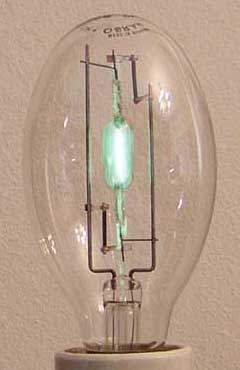
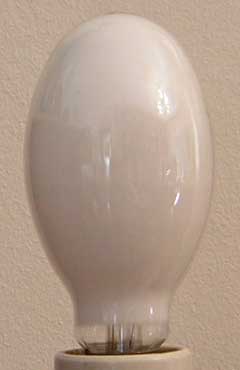



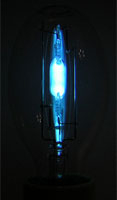


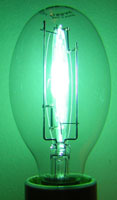
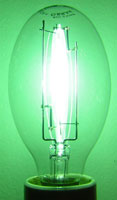
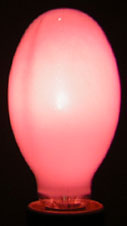
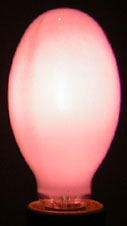
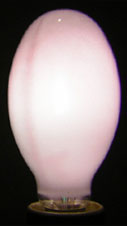
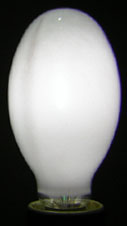
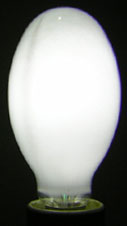
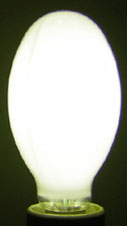
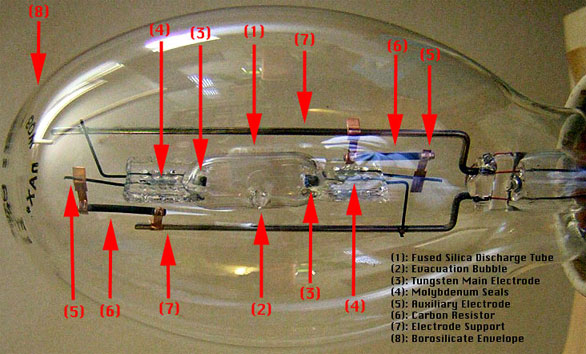
The two auxiliary electrodes are connected to opposite ends, each via a 8-10 kOhm carbon resistor. The main electrodes are connected to the mains, through a current limiting device, such as an inductive resistor or ballast[1] (Fig. 2), to limit the current of the lamp. Without such a current limiting device, the lamp gets destroyed on start, because gas discharges are negative resistance devices, hence the current tends to go to infinity as all gas discharges tend to draw more and more current, eventually causing a runaway current scenario.
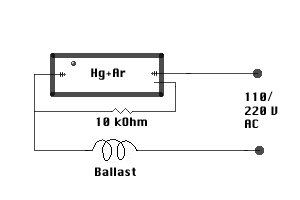
When the lamp is properly wired, the existing voltage initiates an argon glow discharge between the main and the auxiliary electrode pair(s), causing a sufficient number of Mercury atoms to be ionized. This in turn initiates a low pressure discharge between the two main electrodes.
The discharge gradually transforms from low to high pressure, elevating the pressure and temperature of the Mercury vapor inside the inner discharge tube, to roughly 2-3 atmospheres and ~1150° Celsius[4] respectively. That's why it's necessary to construct the inner discharge tube from fused silica, which has a melting point around 1,700° Celsius. Under these conditions, the emission lines of Mercury are thermally broadened and partially self-absorbed.
The lamp emits all the visible lines of Mercury and a little continuum[3]. The radiation from the inner tube is particularly dangerous to eyes and skin, as such radiation includes lines in the shortwave ultraviolet which can cause severe eye and skin burns, including conjunctivitis and skin erythema. Prolonged exposure to such radiation, may cause blindness and skin cancer, as it causes alterations to the DNA of epithelial skin cells. NEVER operate a Mercury vapor lamp, if the outer bulb is broken[2].
For the above reason and for other reasons, such as thermal insulation, the inner tube is enclosed in an outer evacuated bulb usually made of hard borosilicate glass. The outer bulb effectively absorbs all shortwave ultraviolet radiation below ~280-300nm, and as such the lamp's light becomes somewhat more benign. Depending on the outer glass type, the lamp still emits lots of mid-longwave ultraviolet radiation and can still cause eye irritation after long exposures near the lamp, particularly when the outer bulb is clear glass[3] which allows actinic UV radiation through.
On the first and second photos the lamp can be seen operating, with the Mercury arc forming between the two main discharge tube electrodes.
The color of the High Pressure Mercury arc is characteristic green/bluish white. Although the intensity of all the visible Mercury lines in the arc is such as to make the lamp's light appear green/bluish white, the lamp's spectrum is severely lacking in red emissions. For this reason, newer types of this lamp have the inner surface of the outer bulb coated with fluorescent phosphors, which utilize the longwave ultraviolet radiation of Mercury and produce additional red emissions. Such a lamp is shown on the third photo, above.
The basic clear outer bulb Mercury vapor lamp is still used in the US in highways, and in back porch security light installations. In Europe the clear Mercury vapor lamp is not in use anymore, because some little old ladies have expressed concern that under its light they look like bloodless cadavers. Of course that's precisely what we are: cadavers with technology, so the latter is especially advantageous in the case of back porch security lighting, since non-cadavers have absolutely no reason to visit your house via the back porch at 3:00 a.m.
The Mercury vapor lamp has evolved considerably, with newer lamps containing additional ingredients in their discharge tubes, to improve the emitted light. These are called Metal Halide lamps. Their color is very much improved, but their control gear is quite complex and they are quite expensive.
In terms of lifetime, the Mercury vapor lamp is still the undisputed champion. There are Mercury vapor lamps in the author's neighborhood in Athens, which the author remembers since he was 8 years old that are still functional (Fig. 4).
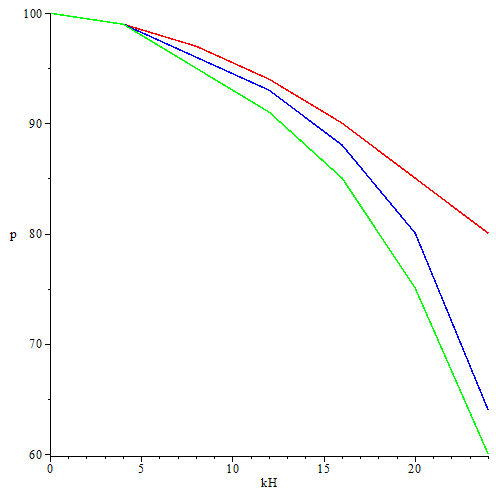
For some strange reason, the author was completely mesmerized and magnetized by the strange color hue of this lamp. Reasons unknown. As the author is also nearsighted, the lamp also had a strange appearance through the edge of his glasses. Regular eyeglasses are non-achromatic, so if you wear corrective lenses for nearsightedness and you look at a light source through near the edge of the lenses, you can see a small spectrum of the light source. The Mercury lamp had a strange bluish halo when I was looking at it near the edge of the author's glasses.
It turns out that this "halo", is nothing more than the blue Mercury spectral line, at 436nm. The color of this line is a mysterious very pleasant and attractive (to this author) Cobalt-blue, and slightly off-focus, when looked at through glasses.
The author subsequently bought a Mercury lamp and a ballast from an electrical contractor and started playing with it. When the lamp was starting, it produced a very pleasant pink glow, which gradually transformed into a bright cool white light, after the lamp completely warmed up.
During high school the author became obsessed with the mercury lamp. It was all he cared about. The author's obsession affected his then school buddy, Dimitris Karapanos[6], who after a while started buying huge mercury lamps of the 1,000 W range himself. The author's fascination was contagious in some strange way.
One day while starting up the lamp, the author took a peak under the lamp's white coating. He had no idea what the white stuff under the bulb's surface was, but noticed that whatever device was hiding under the outer bulb, produced light which was quite different from the light of the entire lamp, seen from the outside of the white coating. The striking contrast between the greenish-blue inner light and the pink outer glow, intrigued him. This was the start.
The author started searching for ways to see more. He acquired a set of cheap prisms and started investigating the spectrum of this lamp. The author was 13 years old at the time. The author's Father saw this interest and although he was away from home, when he died in 1986, the author found this small brand new hand-held spectroscope in his Father's personal belongings.
The culmination of the author's efforts to investigate the Mercury vapor lamp, led to a large collection of lamps based on the criterion that each member of this collection should have a different spectrum.
This is the author's latest spectroscopic investigation into the world of light sources, over a period of almost 30 years. During these years, technology changed, most Mercury vapor lamps in his neighborhood were replaced with Sodium vapor and Metal Halide lamps, but the author's first fascination with the original Mercury vapor lamp, remains alive to this day.


Mercury expresses most of the author's character traits very well, so during his investigations he developed a strange attraction to the element Mercury, itself. In high school he stole 2 kg's from the physics lab (later returned) and gradually acquired small quantities of it and kept some for personal use. The author also used to wear a mercury pendant. Essentially all that this author is (from a scientific standpoint) is the result of his fascination with the mercury vapor lamp and the element Mercury.
You may be well aware that several countries have banned the use of Mercury from most medical and scientific products as we speak. This should be A VERY CLEAR INDICATION to you that the price of inappropriate handling, use or experimentation with this element (even in very small quantities), may carry a fairly ugly fate heath-wise[5].